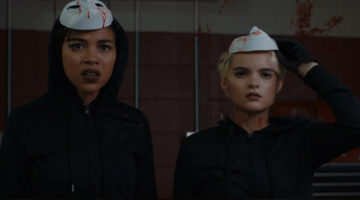TAD 2013 Review: Willow Creek
While the found footage genre has become a spent novelty, Willow Creek finds a rare amount of freshness in an expired product. Certainly not great, and arguably not even very good, this latest Blair Witch-imitator, due to the snarky sensibilities of its director Bobcat Goldthwait (God Bless America, World’s Greatest Dad), manufactures enough humour and horror to justify its existence.
At Toronto After Dark, Goldthwait admitted he was not a fan of the genre’s logic gaps, such as how are these films actually “found”, and what producer would want to present a recording of a massacre on camera in the first place? Found footage films can be interesting, I suppose, when they address a characters’s selfish need to find and record the “truth”, or how the home-video style captures the broken, discontinuous shape of reality. One is character-oriented, the other aesthetic.
And fortunately, Willow Creek achieves a startling amount of authenticity through its visual gimmick. The film to compensate however has to devote about an hour of its 100-minute run time just to get into the swing of its faux-documentary style – showcasing bloopers, awkward cuts, elongated takes, etc.
These touches serve the choppy, amateur abilities of couple Jim (Bryce Johnson) and Kelly’s (Alexie Gilmore) to report on the Bigfoot myth at Bluff Creek. The two are completely out of their element not only because of their lackluster journalism skills in the small town but, in the more unsettling second half, their bad sense of direction in a labyrinthine wilderness (which they were told by several of the local rednecks to strictly avoid).
Willow Creek’s attitude starts in disbelief towards the Bigfoot mythos. Sure, Jim is the more over-zealous of the two, but his shameless credulity is the main source of the film’s humour. Right away, we get Goldthwait’s ambivalence – to the myth and the aforementioned genre. As the two characters roam across town (you want to call it Twin Peaks, but that’s taken), they interview an assortment of locals, who deliver anecdotes about their experiences of Bigfoot, and others who quickly dismiss the idea.
Before Jim and Kelly enter the woods, Goldthwait makes it clear that this expedition is an ego trip for the former. Jim is so impulsively driven to prove (or disprove) the 1967 footage of Bigfoot by Roger Patterson and Robert Gimlin that we often hear him changing his “I”s for “We”s as if convince his girlfriend this is a group effort. But he simply wants to make a movie for his own sake, like how Jack Torrance used the Overlook Hotel for his writing. He didn’t give a hoot about his loved ones.
To his credit, Jim is not an ax-wielding psychotic. He’s a sympathetic character, and Goldthwait does a reasonable job with improvisation to generate emotional interest in the characters. But Goldthwait is also a pitch-black humorist so he’s not simply pleading for our compassion. As Willow Creek takes a darker turn, the cheeky director is blunt with the terrifying chaos. He doesn’t beat around the bush with the horror elements, but instead rushes to the finish in order to emphasize Jim’s way-too-late confession: “I fucked up”. Alas the horror, like in The Blair Witch Project, certainly startles but does not reveal the unearthly creature.
Nevertheless, Willow Creek may earn a share of scares and laughs, but at the same time it doesn’t have much of an edge. Both elements come in modest amounts, and the leftover interest is for those openly fascinated by the Bigfoot myth. Others may be stranded as they struggle to take the concept seriously. Luckily, Goldthwait is not somber about his goofy subject, but also not exactly committed. Willow Creek is more of a portage, where another World’s Greatest Dad surely awaits on the other side of the waterway.
[star v=3]





